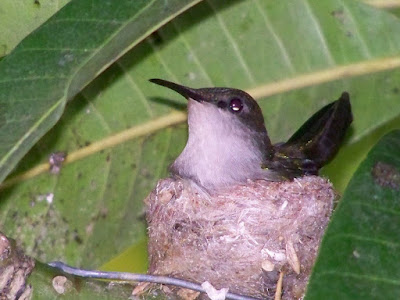
these babies will be ready to leave the nest in 21 days


I peeped in to make sure that everything was ok when I saw this !

I got a piece of wire and bent it to hook onto the branch supporting the nest

so I decided to do some renovations and put in some additional support

Yesterday when I had gone to check on the nest it had tilted to a dangerous angle, and I was afraid that the eggs will fall out.

the antillean crested female, notice its straight bill

the emerald throated humming or the green throated carib bird, the larger of the two species we have on the island with its long curved bill


I have managed to capture some photos of the emerald throated humming bird, these are not the best photos however that is what I can manage so far. Yes the babies are out and in twenty one days they will be ready to leave the nest. Humming birds need lots of nectar for energy and will feed on white flies for their protein. Humming birds are the smallest birds in the world, the smallest humming bird is the bee humming bird from Cuba which measures a little more than 5 cms (2 inches) from bill to tail. Humming birds have the fastest metabolic rate of any warm blooded animal. They are capable of flying backwards to the left and right, hovering and even flying upside down. They have the fastest beating wings as well as being the fastest flyers in the animal kingdom. They are very territorial creatures and fights break out regularly around my feeder.
 look at those babies, they have grown already. Notice the beak /bill and the downy covering on the skin
look at those babies, they have grown already. Notice the beak /bill and the downy covering on the skin the female antillean crested humming bird keeping her chicks warm. She actually allowed me to come quite close without leaving her nest.
the female antillean crested humming bird keeping her chicks warm. She actually allowed me to come quite close without leaving her nest.



















































